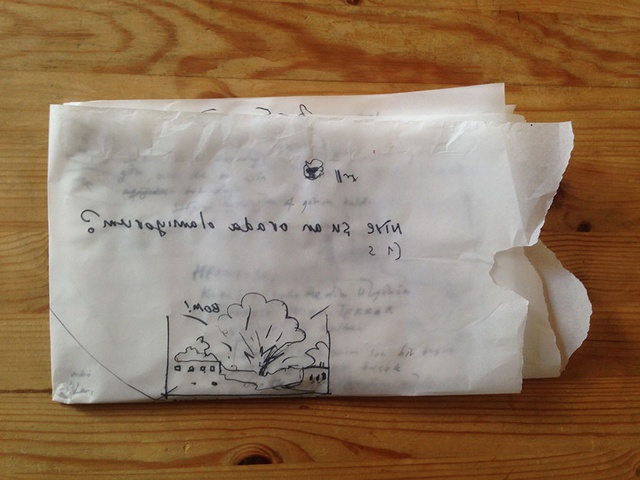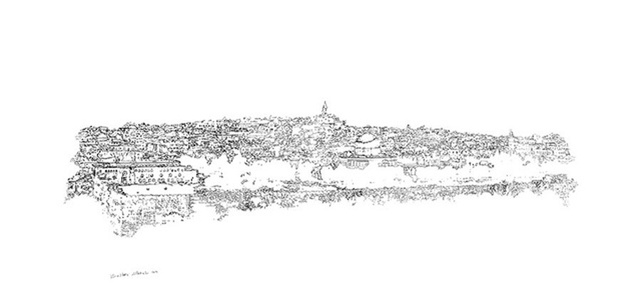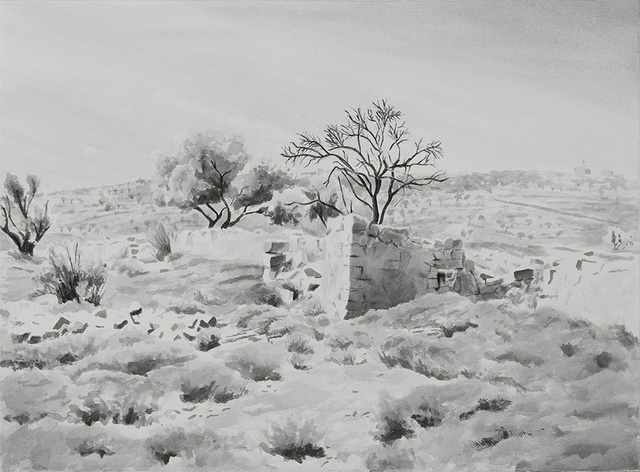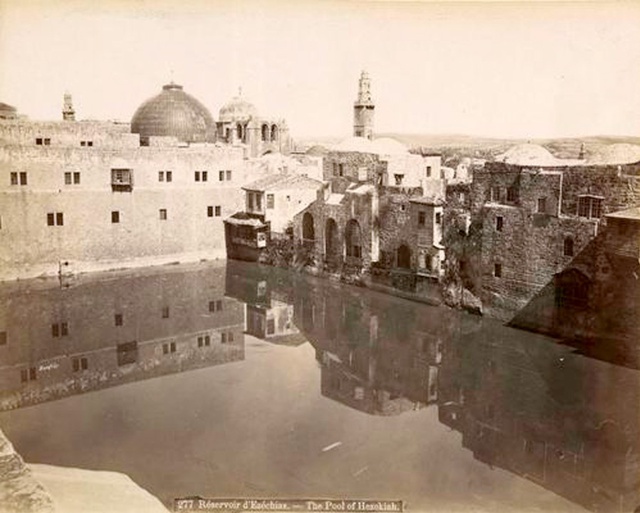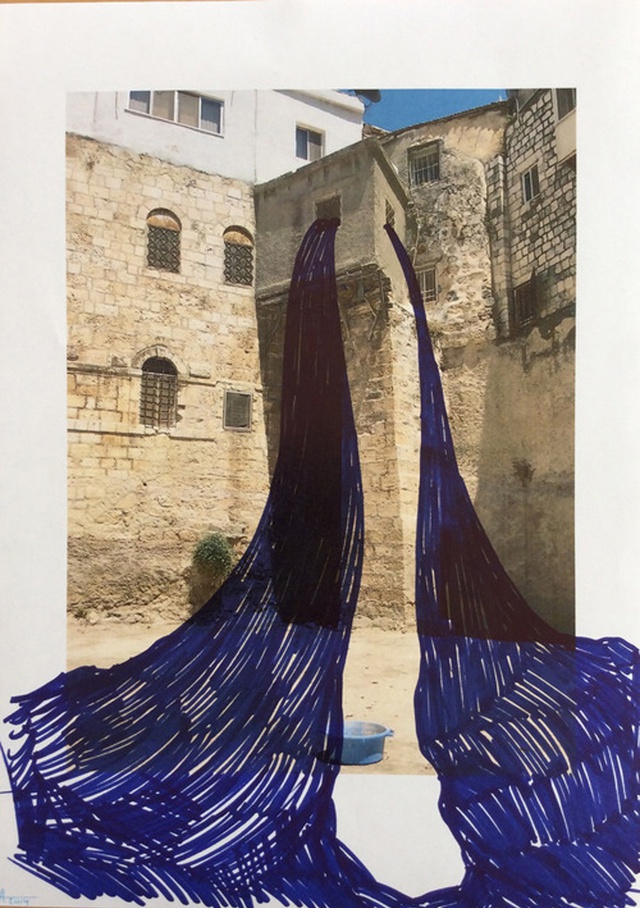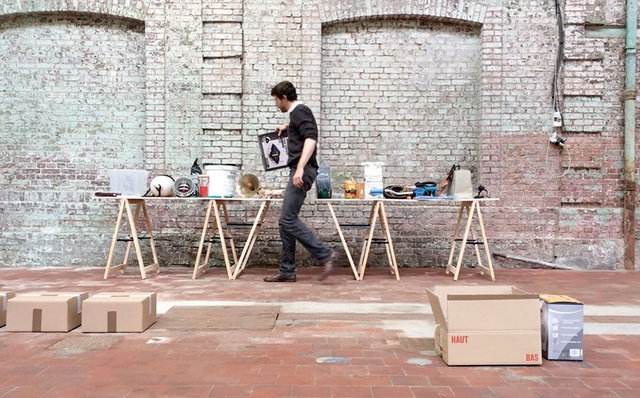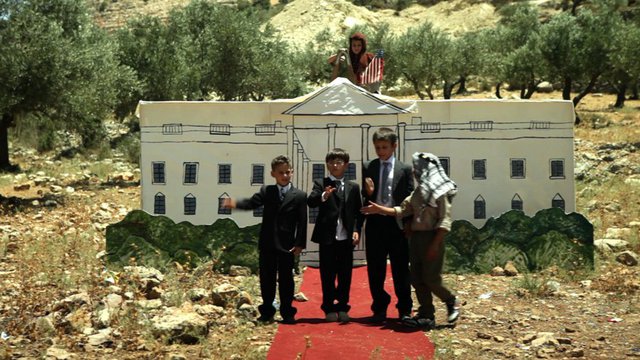Publications
The Jerusalem Show
A View from Afar: Stephanie Bailey
Outside Looking In
Taking a Title and Running With It*
Stephanie Bailey
This essay will take the title, Fractures, as a point of departure from which to consider this exhibition and its sentiments from afar through physical absence and virtual presence. A fracture, after all, suggests a split: a crack through which we might view an inside from the outside. At the same time, a fracture heralds an emergence, in that substance once contained below the surface might seep out into the open through a gap.
I will consider how the title of this exhibition frames the contemporary moment from a global perspective. A time in which a new world is emerging out of the structures of the twentieth century and its nation states and moving into an era shaped by burgeoning global infrastructures and extrastatecrafts.[1] This exercise takes into account the relationship between mass mediation and migration – what Arjun Appadurai posited are the 'two facts that underpin … the cultural politics of the global modern'.[2] These are, after all, transglobal times. A time in which, as Eric Hobsbawm wrote, 'globalization does not simply sweep away regional, national, and other cultures, but combines them in a peculiar way.'[3]
And we are transglobal citizens, too: even if our experience of the world beyond our locales is purely – or predominately – virtual. This is something Cevdet Erek highlighted by submitting a project to The Jerusalem Show VII that essentially explains the reason for his absence: 'a series of texts and drawings that document the process and the content of two new works – Faça (2014), shown in Athens, and A Room of Rhythms (2014), shown at Curva, MAXXI, in Rome.'[4]Both were presented just before and during the opening of The Jerusalem Show VII.
A such, what better way to consider this contemporary moment than through an art exhibition that has brought together 25 artists from around the world to respond to a city that recalls Hobsbawm's assertion that, 'though the globalized world leads to a kind of assimilation to a predominant (western) pattern within technologically-governed sides of life' (office and airport design, for instance), 'it has also lead to a heterogeneous cultural confusion, coexistence and syncretisms'?[5] When it comes to the palpable changes unfolding globally today, it is in Jerusalem – this contested and divided space – that such global confusions converge and collide. ('Can the outlines of the future be read in the small towns of Ecuador and the nightspots of Lhasa?' Hobsbawm asked. 'But why not?')[6]
Indeed, when considering the dynamics that exist within Jerusalem, a point Illan Pappé made during a discussion with Decolonizing Architecture Art Residency (DAAR: Sandi Hilal, Alessandro Petti and Eyal Weizman) at Tate Modern in May 2014 comes to mind. Discussing the ongoing Israeli-Palestinian conflict through DAAR's presentation of a collective practice that works within the Palestinian territories and camps, Pappé noted that the world is experiencing a transition from a national to post-national condition.[7] His observation could not have been timelier. Soon after the event, Israel launched Operation Protective Edge over Gaza: an event that confirmed what was concluded during the question and answer session at that Tate Modern discussion. This is not only a post- but also a neo-national era: something the conflict between Israel (a national body maintaining its fragile statehood) and Palestine (a national body asserting – even defending – its right to statehood), clearly demonstrates.
This is the transition point Pappé pointed out: a meta-condition that constitutes a state of flux between a past and a future located in the space of the present, which here operates like a fracture or a gap – a space that joins two halves together as they continue to move apart. Appadurai picked up on such dynamics in the nineties, when he wrote: 'As the nation state enters a terminal crisis … we can certainly expect that the materials for a post-national imaginary must be around us already.'[8]
Here, we return again to the title of this exhibition, Fractures, and the city within which it is being staged. The fractious conditions we might perceive in Jerusalem, let alone the state of Israel, extend far beyond the Palestine-Israeli conflict and its myriad schisms. Take Europe, where a kind of post-nationalist unification has produced a rise in neo-nationalism in recent years. In fact, in September 2014, The New Scientist released an issue on the end of the nation state with an editorial suggesting that 'the nation's time may be drawing to a close.'[9] The example of post-nationalism cited in this editorial was not only the European Union, 'which is trying – much to the disapproval of many Europeans – to transcend its member nations,' but ISIS, too, and its designs for a neo-caliphate that recognizes no borders.[10]
Interestingly, the New Scientist editorial described ISIS as hypermodern: 'more of a network than a nation, having made canny use of social media to exert influence far beyond its geographical base.'[11] This brings to mind Appadurai's view of diasporic public spheres – 'the crucibles of a post-national order':[12] produced through mass mediation, and which link producers and audiences across national boundaries. These spheres are intimately connected with international migration and the transnational movements of national ethnicities who – for one reason or another – operate beyond the confines of a single nation-state. As members increase, multiple nodes within a larger diasporic public sphere emerge.[13]
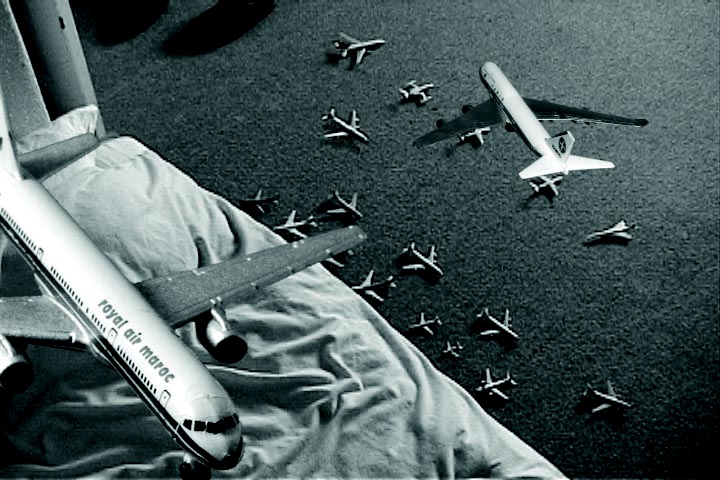
This brings us back to The Jerusalem Show VII and its title, now considered here in the plural. Fractures suggest multiple ruptures: a breakdown of form into an archipelago of pieces that still constitutes a whole somehow marked by the fractures themselves – a delineation of a network. In many ways, it is in this condition that the Palestinian state exists, fragmented both locally within the Palestinian territories, and globally, in the form of the refugee camps and the diaspora. Yet, this networked, transnational existence is not limited to the Palestinian experience, nor is it limited to the temporal context of now. After all, if history tells us anything, it is that globalization is really nothing new.
Take Constantine Cavafy, the Alexandrian Greek who wrote his poem Ithaca in 1911. It was modelled on the Homeric story of Odysseus, the man who, due to the forces of world history, was somehow ripped from the place of his birth and cast adrift. The lesson Cavafy imparts through Ithaca is the act of letting go to the illusion of what has already been lost. In the end, home – 'Ithaca', though any other name would do – becomes an illusion. This perception informs Hiraki Sawa's work, presenting two projects as part of The Jerusalem Show VII: Dwelling (2002) and Migrations (2003). These explore the sense of being nowhere, the continued displacement of migration, and the different meanings of moving, going beyond borders, and the gaps between things.
Indeed, as Cavafy concluded, home is not so much the destination as it is the journey: the movement from one place to another. Decolonizing Architecture's Sandi Hilal made the same point in 2014 when discussing the Right of Return and asking a question that recognizes the reality that Palestinian homes have been lost and lands have been irrevocably changed: 'return to what?'[14]
Thus arises the need to perform archaeologies of history, memory and experience, and to produce proposals for future architectures beyond our desire to resurrect a spectral past: that elusive 'home'. Only then might we be face an inconclusive present mired by global inequality and instability for what it is, and make something more out of it. It is this logic that informs Bashar Alhroub's project, Less Holiness, a drawing presented at Al-Ma'mal (The Tile Factory), which intends to dismantle the stereotypical image of Jerusalem as a holy city so as to expose what lies behind it: what Alhroub calls 'a reality of struggle and fragmentation'.[15] In the case of Benji Boyadgian, his response also seeks to bring another view of the city to light through paintings depicting the ruins of field houses, Qusurs or Manateers, in Wadi el-Shami: what he describes as 'a timeless journey in this fractured landscape, transcended from its context'.[16]
In this, the theme of The Jerusalem Show VII – being part of the wider programme of the 2nd Qalandiya International and its myriad events organized under the notion of lived and shared archives (launched this year against all odds and thanks to a network of supporters within Palestine) – presents a proposition. An invitation to find ways of repairing, or transcending, a fractured territory in fractured times by filling social, political, and even historical gaps (or erasures) with relational – and creative – flow. It is an approach encapsulated in Hera Büyüktaşçıyan's site-specific installation The Recovery of an Early Water, which retraces the presence of one of Jerusalem's lost water supplies, Hezekiah's Pool: once a reservoir that was built during the reign of King Hezekiah, and which has been dry since 2010.[17]
Büyüktaşçıyan's idea is simple. In attempting to revive the memory of this water, which in turn was connected to the city's ancient water systems, she attempts at producing a sub-cartography that transcends surface division and uncovers unseen connections and relations. Water, after all, is a connector: Adelina von Furstenberg's 4th Thessaloniki Biennale was themed around the Mediterranean as a unifier, just as DAAR is now exploring the Mediterranean as a site of return.
Indeed, through her research, Büyüktaşçıyan visualizes the invisible connections between things, just as the space between artworks in a curated show is activated by the connections and observations made not only by curators, but by viewers, too. Here, space impregnated with histories, experiences, and lessons becomes the fracture that connects rather than divides: because gaps can be filled not only with bodies, structures and objects, but also with meaning.
In thinking about this, let us return to that description of ISIS as hypermodern – more of a network than a state – and Appadurai's conceptualization of the politicized diasporic public sphere. Both notions recall what Jolle Demmers has asserted in terms of how conflict today has changed because 'nationalism has changed: the phenomenon has outgrown its definition.'[18] Demmers continues: 'globalization (including the internationalism of labour, mass migration) has not meant the end of nationalism. Instead, nationalists … have begun to carry out their struggles on a global scale. National communities are being 'imagined' in a new, (delocalized) way.'[19]
In this emergent post-national – fractured – world of networked states, nations, and subjects (not necessarily bound to territory), we see what Appadurai calls an emergent post-national order that operates as a system 'based on relations between heterogeneous units (some social units, some interest groups, some professional bodies, some non-governmental organizations, some armed constabularies, some judicial bodies).'[20] In other words, a system that operates horizontally as a matrix, a network, or a web, in which dissonance rather than consensus is the norm.
We might consider the global art world one such system, with its myriad international exhibitions, biennials and art fairs (The Jerusalem Show included) and the increasing need for cultural practitioners to travel extensively. Take the multiple levels of circulation embedded in Jonathan Loppin's performance project, Blocus. Travelling to Jerusalem for The Jerusalem Show VII, the artist will unpack a box of items in five different locations, each item collected from a list compiled in 2010 by Gisha, an Israeli human rights association identifying what has been prohibited from importation into the Gaza strip by the Israeli authorities. In this, the presentation of Blocus treads a fragile line: in an attempt to carry an entire list of prohibited goods over into Palestine, Loppin is using his role as a trans-national artist – and the universal framing of these objects as art – as a position with which to transcend border restrictions while drawing attention to them.[21] It is an approach that recalls Markus Miessen's view that, though the autonomy of the art world can render its spaces privileged, introverted and apolitical, 'this autonomy, on the other hand, is its potential: a test-ground...'[22] To this effect, is the art world also hypermodern and post-national? A space in which the traces of the future might already be found?
Of course, when thinking about the challenges that come with post-national emergences, Appadurai noted that we must bear in mind 'whether … heterogeneity is consistent with some minimal conventions of norm and value, which do not require a strict adherence to the liberal social contract of the modern West.'[23] For Appadurai, this will be answered 'by the negotiations (both civil and violent) between the worlds imagined by these different interests and movements,'[24] and in the short run, what we experience, he said, 'is likely to be a world of increased incivility and violence.'[25] Here, let us consider Miessen's words again, this time on the legitimacy of conflict, which he insists 'must be fostered in a productive way.' That is, 'to be able to appear as one voice which still maintains the potentiality of divisions, breakages, and individual positions of its members.'[26]
How we negotiate social and global conflict, not to mention state and corporate violence, is the challenge we face in our fractious times: a hypermodern age in which nation-states are subsumed, infiltrated and, in many ways, diluted within the frame of contemporary globalism (and capitalism). No context is isolated: as social contracts are broken and contested around the world through such waves as the Arab uprisings, the indignant and Occupy movements and, most recently, the Gezi and Hong Kong protests, the twenty-first century is raising questions that are global in nature. Jumana Manna and Sille Storhile's The Goodness Regime, filmed between Norway and Palestine and which charts a relation between modern Norway and the 'theatre of the Oslo Peace Accords' reflects on this explicitly.[27]
In this, the question of what positions we take in response to what we witness – even at a distance – is paramount. It is a challenge not unlike the experience of viewing – and interpreting – an art exhibition, or even the experience of artists tasked with producing art works that speak to a city that is not their own. Indeed, it is a relational challenge that arose in much broader terms when Operate Protective Edge unfolded in the summer of 2014, during which John Pilger observed: 'The attack on Gaza was an attack on all of us. The siege of Gaza is a siege of all of us.'[28] Here, what was and remains at stake – aside from localized and indeed delocalized struggles for self-determination and basic rights – is the wider narrative of global conflict that has exploded post 9-11: a state of exception that has become the norm, in which, as Agamben once observed, 'emergency becomes the rule, and the very distinction between peace and war (and between foreign and civil war) becomes impossible.'[29]
Perhaps the ultimate challenge is how we view and experience not only our immediate realities, but also those that are experienced online, or at a certain remove. How do we engage with global culture and its fractures either from within, or from without? If we can figure this out, then we might imagine ways to live together, albeit in some kind of affirmed (indeed, fractured) dis/harmony.
As Adorno once wrote, 'knowledge comes to us through a network of prejudices, opinions, innervations, self-corrections, presuppositions, and exaggerations, in short through the dense, firmly-founded but by no means uniformly transparent medium of experience.'[30] When discussing the Palestinian experience today, Decolonizing Architecture writes: 'the only state we know is a state of conflict and struggle.'[31] And this struggle, as Sandi Hilal explained in 2014, is one that imagines a world the day after revolution, or a world in which revolution – that violent rupture – is not the end point. After all, as Appadurai predicted some twenty years ago: the work of the imagination and the emergence of a post-national order (or a new global imaginary) are linked.[32] We must bridge that gap.
* This essay's sub-title was conceived with Guy Mannes-Abbott's In Ramallah, Running (Black Dog Publishing) in mind.
[1] Extrastatecraft – a term coined by Keller Easterling to describe a portmanteau that means both outside of and in addition to statecraft-recognizes that infrastructure generates emergent new constellations of national, international, intergovernmental and transnational administration and generates undeclared forms of polity faster than any even quasi-official forms of governance can legislate it. See: http://extrastatecraft.net/About
[2] Arjun Appadurai, Modernity at Large: Cultural Dimensions of Globalization, (University of Minesotta Press: Minneapolis, MN: 1996), p. 21
[3] Eric Hobsbawm, Fractured Times: Culture and Society in the Twentieth Century (The New Press: New York, 2014), p. 24.
[4] To see more of the project on Ibraaz, follow this link: http://www.ibraaz.org/publications/4#_ftn8
[5] Hobsbawm, p. 26.
[6] Ibid.
[7] Stephanie Bailey, 'Architecture After Revolution: Decolonizing Architecture at Tate Modern', Ibraaz.org, 29 July 2014, http://www.ibraaz.org/news/100.
[8] Appadurai, p. 21
[9] Editorial, 'State of the Nation', The New Scientist, 6 September 2014, No.2985, p. 3. For the online version see: http://www.newscientist.com/article/mg22329851.500-in-our-world-beyond-nations-the-future-is-medieval.html - .VEezdOfHMXw
[10] Ibid.
[11] Ibid.
[12] Appadurai, p. 22.
[13] Appadurai, p. 22.
[14] Stephanie Bailey, 'Architecture After Revolution: Decolonizing Architecture at Tate Modern', Ibraaz.org, 29 July 2014, http://www.ibraaz.org/news/100.
[15] To see more of the project on Ibraaz, follow this link: http://www.ibraaz.org/publications/4#_ftn6
[16] To see more of the project on Ibraaz, follow this link: http://www.ibraaz.org/publications/4#_ftn4
[17]To see more of the project online, follow this link: http://www.ibraaz.org/publications/5#_ftn3
[18] Jolle Demmers, 'Diaspora and Conflict: Locality, Long-Distance Nationalism, and Delocalisation of Conflict Dynamics', The Public, Vol.9 (2002), 1, p. 93.
[19] Ibid.
[20] Appadurai, p. 23.
[21] To see more of the project on Ibraaz, follow this link: http://www.ibraaz.org/publications/5#_ftn8
[22] The Violence of Participation, (ed. Markus Miessen), Sternberg Press, B26.
[23] Appadurai, p. 23.
[24] Ibid.
[25] Ibid.
[26] The Violence of Participation, (ed. Markus Miessen), Sternberg Press, B24.
[28] John Pilger, in a text adapted from John Pilger's Edward Said Memorial Lecture, delivered in Adelaide, Australia, on 11 September 2014: http://johnpilger.com/articles/breaking-the-last-taboo-gaza-and-the-threat-of-world-war
[29] Giorgio Agamben, The Age of Exception as a Paradigm of Government (Univeristy of Chicago Press: Chicago, 2005), p. 22.
[30] Theodor Adorno, Minima Moralia: Reflections from a Damaged Life, trans. E. F. N. Jephcott (Bristol: NLB, 1974), p. 80-81.
[31] Decolonizing Architecture Art Residency, Architecture After the Revolution, Sternberg Press, 2013, p. 31
[32] Appadurai, p. 22.

